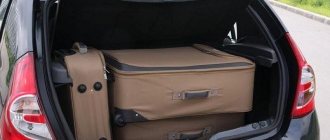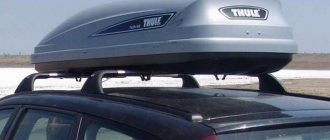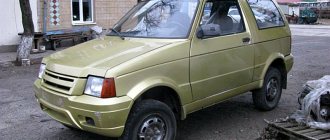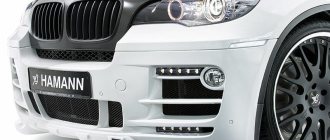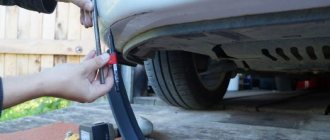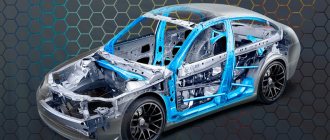Home / Repair manual Ford Focus 2 / Technical characteristics of Ford Focus 2
Ford Focus 2 became popular in Russia for a reason. Thanks to the good price/quality ratio, as well as good technical characteristics , competitors in its price range have a hard time.
The car was originally presented at the Paris Motor Show in 2004. The car immediately gained wild popularity. 4 years later, in 2008, the model underwent restyling; only the exterior and interior of the Focus changed slightly (which is quite logical for restyling), but the technical characteristics did not change.
In Russia, the car is available from official dealers in the following basic configurations:
- Ambiente (one airbag, front seat belt pretensioners, front electric windows, central locking and immobilizer, adjustable steering column for reach and angle)
- Comfort (the above Ambiente options + additionally there is air conditioning, aluminum trim on the interior door handles, body-colored side moldings and exterior door handles);
- Ghia (the above Comfort options + additional wood trim, a different seat profile, central locking with remote control, cooled glove box, electric windows for all doors, 4 airbags: two front + side, additional interior lighting for rear passengers, system delays in turning off the headlights when leaving the car, electric side mirrors, a rain sensor, a light sensor, a self-dimming rear-view mirror, a chrome grille surround, an armrest for the driver and other changes in the interior).
- Titanium - the above Ghia options + additionally some changes in the interior.
By special order, the car can be equipped with an anti-lock braking system (ABS) with an electronic brake force distribution (EBD), a dynamic stabilization system (ESP), separate climate control, xenon headlights, parking sensors, alloy wheels (several options), the possibility of installation of voice control for a mobile phone.
Technical characteristics of Ford Focus 2
The technical characteristics of the Ford Focus 2 are proof of its unconditional leadership in its price segment, expressed in numbers. Even a short glance at the technical data of the Ford Focus 2 will be enough to understand that the Ford Motor Company has taken, albeit not a gigantic, but still a firm and confident step towards improving the acceleration dynamics, as well as the driving performance of a car so popular in Russia. According to critics, in its incredible combination of dynamics and handling, the second version of the Ford Focus is even somewhat superior to the famous Volvo 40 and Mazda 3, which are based on the same Ford C1 platform.
dimensions
| Body type | hatchback | sedan | station wagon |
| External dimensions | |||
| Overall length, mm | 4337 | 4481 | 4468 |
| Overall width (including external mirrors), mm | 2020 | 2020 | 2020 |
| Overall height (without roof rack), mm | 1497 | 1497 | 1503 |
| Turning diameter, m | 10.4 | 10.4 | 10.4 |
| Luggage compartment volume, cubic meters m | |||
| 5-seater version (with full-size spare wheel) | 282 | 467 | 482 |
| 2-seater version (with full-size spare wheel) | 1144 | — | 1525 |
| Fuel tank volume, l | |||
| Gas engine | 55 | 55 | 55 |
| Diesel engine | 53 | 53 | 53 |
Engine characteristics 1.6i Duratec 16V (100 Hp)
| Engine location | Front, transverse |
| Engine capacity | 1596 cm3 |
| Power | 100 hp |
| At rpm | 6000 |
| Torque | 143/4000 n*m |
| Supply system | Distributed injection |
| Presence of turbocharging | — |
| Gas distribution mechanism | DOHC |
| Cylinder arrangement | Row |
| Number of cylinders | 4 |
| Cylinder diameter | 79 mm |
| Piston stroke | 81.4 mm |
| Compression ratio | 11 |
| Number of valves per cylinder | 4 |
| Fuel | AI-95 |
Weight and payload
| engine's type | Vehicle curb weight, kg* | Gross vehicle weight, kg | Trailer weight with brakes, kg | Trailer weight without brakes, kg |
| 1.4 Duratec | 1352-1404 | 1750 | 655-700 | 610-635 |
| 1.6 Duratec | 1349-1404 | 1820 | 1200 | 610-635 |
| 1.6 Duratec, A4 | 1378-1435 | 1835-1845 | 800 | 625-650 |
| 1.6 Duratec Ti-VCT | 1362-1405 | 1825 | 1200 | 615-635 |
| 1.8 Duratec | 1402-1495 | 1835-1895 | 1080-1200 | 640-670 |
| 2.0 Duratec | 1420-1473 | 1895 | 1400 | 650-675 |
| 2.0 Duratec, A4 | 1427-1487 | 1905 | 1300 | 660-685 |
| 1.8 Duratorq TDCi | 1481-1542 | 1950 | 1500 | 685-710 |
* Represents the minimum curb weight assuming the driver weighs 75 kg and the vehicle is fully filled with fluids and 90% fuel. This weight may vary due to design changes, installed options, etc. Dynamic parameters and fuel consumption of all models deteriorate when towing a trailer.
Body selection
Well, it was written just for funI don’t have “digits”, I won’t argue. But you're not carrying air in the trunk, are you? If there is air, then there is no doubt that you will carry more of it in a sedan (based on the above values). But in fact -Ant-
He said correctly, there is volume in the sedan, but it is stupid. Specific example:
For me, since childhood, this has been an axiom, because... Dad subscribed to “Behind the Wheel” and “Auto Review”, and I read from cover to cover.
But, so as not to be unfounded, a few arguments:
1) from an article in Autoreview (you can find it in Yandex by searching “autoreview life is tougher”)
2) this issue was also discussed at the Mazda club. (you can find it in Yandex by searching “Hatchback or Sedan? Hatchback or Sedan? The agony of choice...”) There, too, one hatch lover wrote that one of the disadvantages of the hatch:
But he was quickly enlightened on this issue, and now this statement is crossed out, and next to it is a note:
3) the fact that 3d is tougher than 5d, I already wrote:
If you have data on the sedan, please contact the studio.
Did not know. This means another plus for our piggy bank.
And this is an even more powerful argument
Because he’s not there. My height is 185, I don’t experience any discomfort from behind. I didn’t have the opportunity to carry taller people in the back - it might be uncomfortable for them, well, you can’t please everyone, and I wasn’t hired to carry anyone.
3d awesome bike! I look at him and almost cum. Whoever I don’t give a ride to, everyone says in one voice: “Damn, that’s cool, the door is big, he looks like a total badass.” So you can’t convince me about the appearance. Well, first of all, 80% of the time I drive alone in the car. I think most people do this. That. in this case, 3d is more convenient, because The door is wider -> getting in and out is more convenient. Of the remaining 20% of driving time, 15% is driving with my wife in the front seat. The arguments are the same, 3D drives 5% of the time - I drive my relatives, to the dacha, friends for a barbecue and workers from the site to the metro. So here too there is not the slightest inconvenience, because... when the front seat is reclined, it moves forward all the way, and forms a gigantic opening through which you can walk with great convenience to the far seat and sit down calmly, while in 5d you are forced to sit down and crawl on your butt to the far seat (this is if 2, 3, or 4 people ride behind and everyone sits on one side). If the landing is on both sides, which rarely happens to me, then a five-door is more convenient here
I don’t have such experience, because... most often everyone is in their own car, and in each there are no more than 2-3 people. I once took some hard-working boys to the lakes for a swim at lunch - 4 people in the back, 2 people in the front passenger and I was driving, but I decided that I wouldn’t do that again, because... This is 560 kg of live meat, and the suspension is already heavy. Because The dimensions of the interior in the sedan and the hatch are the same, then if desired, the same 9 people can be stuffed into the hatch, while in the trunk it will be possible not to stuff them, but to seat 3 more people, and they will be able to communicate with those in the cabin on equal terms, because . the trunk in the hatch is part of the interior so The sedan is again an outsider
Main technical characteristics of Ford Focus II
All figures are based on tests conducted by Ford on base-equipped vehicles with standard wheels and tires. Wheels and tires purchased as options or accessories may affect emissions and fuel consumption.
How fuel consumption is measured
All measurements and tests are carried out in laboratory conditions. When measuring fuel consumption in the urban cycle, the engine is started in a cold state. To ensure realistic conditions, the engine operates at different speeds. The maximum speed during testing is 50 km/h, the average speed is 19 km/h, the expected travel distance is 4 km. Immediately after the urban cycle, tests are carried out for the suburban cycle. Half of the improvised area moves at a constant speed. The maximum speed is 120 km/h, distance is 7 km. When calculating the indicators of a mixed cycle, the average values for previous cycles and the distance traveled in each of them are taken into account.
In addition, on our website you can compare the technical characteristics of the Ford Focus 3.
Other Ford Focus parameters:
| Bare body weight max (kg) Maximum vehicle weight for different modifications Data are presented in kilograms (kg) | Modifications Number of model modifications in our database Body weight of Ford Focus II |
| Parameter Vehicle Parameter |
| Total weight of the Ford Focus car | |||
| General view General view of the car | Curb weight min (kg) Minimum vehicle weight for different modifications of Ford Focus | ||
Data are presented in kilograms (kg)
| Curb weight max (kg) Maximum vehicle weight for different modifications Data are presented in kilograms (kg) | Modifications Number of modifications of the model in our database | ||
| 1060 (kg) | 1655 (kg) | 274 |
| Weight of Ford Focus car | |
| Parameter Vehicle Parameter | |
| Value Parameter value in (kg) Warning: The above data are official figures from manufacturers, however, it should be noted that the information is for reference only and does not guarantee absolute accuracy. Source |
Ford Focus 2 trunk volume: lay out on the shelves
Focus is one of the ten best-selling cars in Europe, and the model is also in demand in Russia. Compact cars were launched into American production in 1998. The C class equipment holds first place among similar models due to its advantageous design, small size and price. One of the selection criteria is the carrying capacity and capacity of the Ford Focus: trunk volume differs for different models.
Trunk volume Ford Focus 2
Depending on the type, Ford Focus 2 has an average volume ranging from 282–1525 liters. Based on the previous classification, FordFocus 2 refers to a car with medium luggage compartments.
The exact dimensions of the Ford Focus 2 trunks are as follows:
Thus, the second generation Ford Focus has a fairly spacious trunk. In the most popular body for the city - the hatchback - the small volume of the standard luggage compartment is more than compensated by the excellent capacity of the compartment in the two-seater version, that is, with the rear seat folded.
Due to the popularity of this particular type in the domestic market, many car owners leave their reviews, including about the trunk capacity. Despite the seemingly small displacement of the luggage compartment of the Ford Focus 2 hatchback (compared to the sedan and station wagon), most note the excellent spaciousness and convenience. When the seat is folded, the dimensions of the space allow you to even sleep in it. The only inconvenience that Focus owners note is the step-difference between the trunk itself and the interior under the seat. By the way, we learned to deal with this drawback by cutting off part of the organizer around the spare wheel.
You can buy a used Ford Focus 2 on the website https://oceanica.com.ua/, which is part of the Columbus Trade group of companies. She is engaged in the selection and delivery of cars from America. They have 10 offices in the following cities: Kyiv, Kharkov, Odessa, Dnepr, Minsk, etc.
Second generation
The Ford Focus 2 line was produced from 2004 to 2011. The most popular foreign car in Russia was originally conceived as a universal middle-class vehicle with an increased trunk size, a spacious interior and an improved design. The concept was developed for three car models with different luggage compartment capacities:
- The trunk volume of the Ford Focus 2 hatchback is 385 liters with body dimensions of 4337x1839x1497 mm. The Focus's capacity can be increased by 270% by removing the seats.
- The Focus sedan has the following body characteristics: length - 4481, width - 1839, height - 1497. Moreover, its trunk is significantly larger than that of the hatchback configuration - 526 liters.
- The station wagon has an average luggage compartment of 482 liters. Station wagon dimensions: 4468x1839x1503.
Types of luggage racks
The internal trunk is a section in the cabin or body of a car, the main purpose of which is to transport luggage. As a rule, this element is present in almost every body. Actually, the body has the greatest influence on the capacity and comfort of using the luggage compartment.
Sedan
A popular body type on the Russian car market is the sedan. Mostly such cars have quite a spacious compartment for transporting cargo. A characteristic feature of the trunk of sedans is its shape. It can be both long and short, deep and shallow, as well as wide and narrow. Another feature of the luggage compartment in such a body is a small door opening, which makes it difficult to place and transport large and oversized cargo, unlike hatchbacks and station wagons.
Also, the convenience and accessibility of the compartment space is influenced by such factors as protruding parts of the body and mechanisms inside it. The straight walls of the compartment greatly simplify the loading and unloading process. With this design, the entire volume is truly useful. A well-designed opening-closing mechanism and lid hinges do not take up much space and do not crush folded items.
Sedan trunks typically come in two general sizes:
Hatchback
The trunk volume of hatchbacks also depends on the car class and model. Despite the apparent capacity, do not be fooled and look for a solid volume in this body type. Designed as a city car, the hatchback will perform the corresponding functions. Due to the large door, the luggage compartment of the hatchback is very convenient, especially for transporting oversized cargo. However, you can significantly increase its volume in a car by folding the rear seats.
On average, the trunk volume of hatchbacks is:
First generation
The car belongs to the golf class, first presented in 1998 in Geneva. Almost immediately they made a splash in the car market, shocking the public with original design concepts in the design of the body and cabin. The following options are available:
- Hatchback (3- and 5-door). The model is small in the line of similar configurations, but at the same time it has a spacious luggage compartment. The capacity of the hatchback is as follows: length - 4174 mm, width - 1700, height - 1440. With a relatively modest size, the Focus trunk is 379 liters. Luggage space increases to 1210.
- The Focus sedan arrived on the market in 1999 and almost immediately gained a reputation as both a family and work car. Dimensions: 4382x1700x1440. With these dimensions, the cargo compartment volume is 490 liters.
- The station wagon is a functional modification of the first release. Its luggage compartment is 520 liters. In addition, devices are installed to secure loads on the roof.


